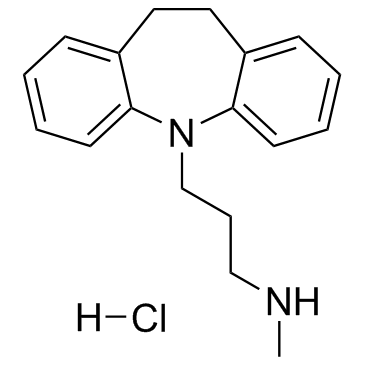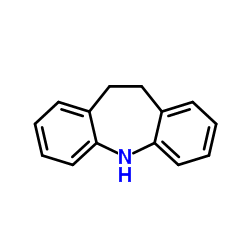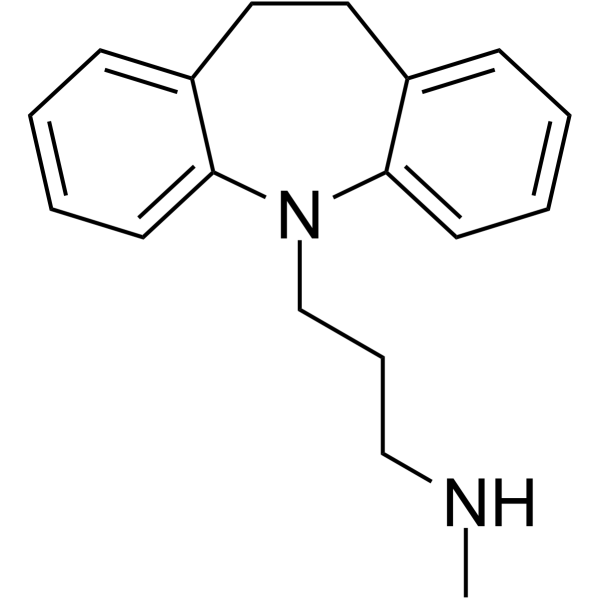58-28-6
| Name | desipramine hydrochloride |
|---|---|
| Synonyms |
5H-Dibenz[b,f]azepine-5-propanamine, 10,11-dihydro-N-methyl-, hydrochloride (1:1)
T C676 BN&T&J B3M1 &&HCl Desipramine hydrochloride Desimipramine Hydrochloride MFCD00058108 irene 3-(5,6-dihydrobenzo[b][1]benzazepin-11-yl)-N-methylpropan-1-amine,hydrochloride EINECS 200-373-1 3-(10,11-Dihydro-5H-dibenzo[b,f]azepin-5-yl)-N-methylpropan-1-amine hydrochloride (1:1) Desipramine HCl 10,11-Dihydro-N-methyl-5H-dibenz[b,f]azepine-5-propanamine monohydrochloride N-(g-Methylaminopropyl)iminodibenzyl Hydrochloride RMI 9384A 10,11-Dihydro-5-[3-(methylamino)propyl]-5H-dibenz[b,f]azepine hydrochloride 3-(10,11-Dihydro-5H-dibenzo[b,f]azepin-5-yl)-N-methylpropan-1-aminhydrochlorid N-(γ-Methylaminopropyl)iminodibenzyl hydrochloride 3-(10,11-Dihydro-5H-dibenzo[b,f]azepin-5-yl)-N-methyl-1-propanamine hydrochloride (1:1) DESIPRAMINEHYDROCHLORIDE |
| Description | Desipramine hydrochloride is an inhibitor of norepinephrine transporter (NET), 5-HT transporter (SERT) and dopamine transporter (DAT) with Kis of 4, 61 and 78,720 nM, respectively. |
|---|---|
| Related Catalog | |
| Target |
Ki: 4 nM (NET), 61 nM (SERT), 78720 nM (DAT)[1] |
| In Vivo | Treatment of rats with Desipramine hydrochloride for 14 days reduces norepinephrine transporter (NET) expression in a dose-dependent manner, as indicated by a reduction of the specific binding of 3H-nisoxetine to the NET in preparations of cerebral cortex (F(3,16)=4.33, p<0.05) and hippocampus (F(3,16)=4.34, p<0.05). This NET down regulation is observed 2 days after discontinuation of chronic Desipramine hydrochloride treatment, a time when plasma and brain concentrations of Desipramine hydrochloride and desmethyldesipramine are undetectable (ie below the 25 ng detection limit of the assay)[2]. |
| Animal Admin | Rats are anesthetized with ketamine (100 mg/kg) and xylazine (10 mg/kg) and implanted subcutaneously with osmotic minipumps preloaded with either vehicle (50% saline, 40% DMSO, and 10% ethanol) or Desipramine hydrochloride at a concentration that delivered 5, 10, or 15 mg/kg per day of the free base. Minipumps are removed, under anesthesia, 14 days later. Rats are tested for antidepressant-like behavior in the forced-swim test 2 to 8 days after pump removal and discontinuation of Desipramine hydrochloride treatment. Following the completion of the behavioral tests, rats are killed by decapitation, their brains are removed, and cerebral cortex and hippocampus are dissected for neurochemical analyses[2]. |
| References |
| Boiling Point | 407.4ºC at 760 mmHg |
|---|---|
| Melting Point | 214-216ºC |
| Molecular Formula | C18H23ClN2 |
| Molecular Weight | 302.842 |
| Flash Point | 160.5ºC |
| Exact Mass | 302.154968 |
| PSA | 15.27000 |
| LogP | 4.79070 |
| Storage condition | 2-8°C |
| Water Solubility | H2O: 50 mg/mL |
CHEMICAL IDENTIFICATION
HEALTH HAZARD DATAACUTE TOXICITY DATA
MUTATION DATA
|
| Symbol |



GHS02, GHS06, GHS08 |
|---|---|
| Signal Word | Danger |
| Hazard Statements | H225-H301 + H311 + H331-H370 |
| Precautionary Statements | P210-P260-P280-P301 + P310-P311 |
| Personal Protective Equipment | dust mask type N95 (US);Eyeshields;Faceshields;Gloves |
| Hazard Codes | Xn: Harmful;F: Flammable;T: Toxic; |
| Risk Phrases | R22;R36/37/38;R42/43;R48/23/24/25;R11 |
| Safety Phrases | S7-S16-S36/37-S45-S26-S24-S22 |
| RIDADR | UN 1230 3/PG 2 |
| WGK Germany | 3 |
| RTECS | HO0525000 |




![3-(5,6-dihydrobenzo[b][1]benzazepin-11-yl)-N,N-dimethylpropan-1-amine structure](https://www.chemsrc.com/caspic/389/50-49-7.png)
![11-[3-(methylamino)propyl]-5,6-dihydrobenzo[b][1]benzazepin-3-ol structure](https://www.chemsrc.com/caspic/111/1977-15-7.png)